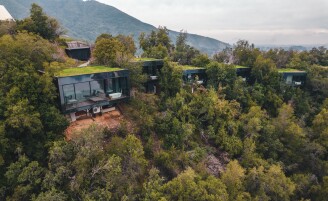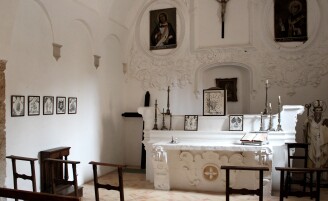P eople who love art usually enjoy the other finer things in life, such as good food, wine, beautiful landscapes and stunning architecture, and now it is increasingly possible to enjoy these pleasures all at once. Across the world the owners of historic buildings and vineyards are boosting their potential as tourism destinations by using them as a backdrop for their art collections.
From stunning wineries in Provence, Chile, Tuscany and California, to castles in Ireland and Italy, a former monastery in Croatia and a coaching inn in Scotland, they have created immersive spaces where a range of cultural and culinary offerings can come together in beautiful surroundings. Some provide luxury accommodation and spas, others are for day trips, but all eight are a feast for the senses.

Hidden in the Scottish Highlands in Braemar, close to the Balmoral Estate – which was bought by Queen Victoria in 1852 and is beloved by the British royal family – the 46 sumptuously decorated bedrooms and suites of this 19th-century coaching inn are inspired by local places and famous visitors to the town. Among them were novelist, poet and essayist Robert Louis Stevenson, who wrote parts of Treasure Island while on holiday in Braemar, and fashion designer Elsa Schiaparelli, who is now commemorated in the Art Deco Elsa’s bar.
The Fife Arms belongs to the art dealers and philanthropists Iwan and Manuela Wirth, co-founders of the international gallery Hauser & Wirth, and the hotel incorporates 14,000 antiques and artworks, ranging from the 16th century to modern masterpieces and contemporary commissions. There is a self-playing Steinway piano decorated by Mark Bradford, portraits by Picasso and Lucian Freud, photographs by Man Ray and Hans Bellmer and a ceiling painted by Zhang Enli. The main restaurant is the Clunie Dining Room, which features a mural by the Argentinian artist Guillermo Kuitca that was inspired by the local landscape.

The Norwegian entrepreneur, creator, sportsman and art collector Alexander Vik and his wife, Carrie, founded the 11,000-acre winery VIK in central Chile in 2006. Visitors enjoy their exceptional, award-winning wines while dining on delicious seasonal menus created with the over 250 different edible vegetables, fruits and flowers grown in the property’s organic garden, along with ingredients sourced locally from farmers and fishermen in the region – all devised by executive chef Pablo Caceres.
A visit to the VIK vineyard and hotel retreats, Vik Chile and Puro Vik, involves an extensive encounter with art. The 22 rooms at Vik Chile and 7 glass-walled bungalows at Puro Vik were designed by Alexander and Carrie Vik in collaboration with architect Marcelo Daglio. Each space is conceptualized in collaboration with individual artists, including works by Alexander and Carrie. Guests are treated as friends staying in the Viks’s home in a luxurious immersive artwork while enjoying 360-degree panoramic views of the spectacular landscape.
The futuristic winery building was designed by Smiljan Radic, a Chilean architect of Croatian descent who also designed the 2014 Serpentine Pavilion in London. The VIK winery is itself a work of art and contains extensive art installations by Chilean Marcela Correa, Uruguayan Eduardo Cardozo and the foremost international light artist, James Turrell.
There are three other Vik Retreats on the Atlantic coast of Uruguay, in José Ignacio which has become the it destination in the Southern Cone: Estancia Vik José Ignacio, Playa Vik José Ignacio and Bahia Vik José Ignacio, as well as La Susana Beach Restaurant, Pavilion Vik and Shack Yoga & Wellness at Vik. In addition, Galleria Vik Milano was launched in 2019 inside the historic Galleria Vittorio Emanuele II in the heart of Milan, Italy.

A visit to the Castello di Ama vineyard, between Siena and Florence in the Chianti region, is a sensory feast. Since 1999 the estate’s proprietors, Lorenza Sebasti and Marco Pallanti, have commissioned sculptures and installations as an offering of thanks to the land and its spirit, which also infuses the philosophy of their winemaking.
Artists who have made works include Michelangelo Pistoletto, Daniel Buren, Giulio Paolini, Anish Kapoor, Carlos Garaicoa, Cristina Iglesias, Louise Bourgeois, Pascale Marthine Tayou, Chen Zhen, Hiroshi Sugimoto, Lee Ufan and Roni Horn. The latest work to be unveiled is a garden installation by Jenny Holzer, which features heavily scented helichrysum flowers and excerpts of poetry by Patrizia Cavalli and W.S. Merwin.
There are five bedrooms in the 16th-century manor house, which allow guests to stay and experience the sculptures at different times of the day in different light. The main restaurant is headed by the family’s personal chef.
Click here to view all Castello di Ama wines available for immediate purchase.

This fortress, near Matera in the southern Italian region of Basilicata, was built to protect a monastic community in the seventh century. It is now owned by the Berlingieri family, who have housed their art collection throughout the property for the past five decades. In 2019 the young collector Aloisia Leopardi was invited to start a programme dedicated to artistic research, experimentation and collaboration.

The castle is now a project space for cultural exchange between artists, curators, collectors and arts professionals, which also aims to encourage the local communities in the surrounding villages to experience contemporary art. Visiting the artists in residence and exhibitions is by appointment only; it is also possible to book a suite or room at the nearby agriturismo, Il Filaro del Castello del Castello San Basilio.
Basilio alumni include the emerging artists Oren Pinhassi, Lucy Henshall, Michele Mathison and Sheida Soleimani. The artists for 2023 will be Kat Lyons and Anna Perach.

Château La Coste in Aix-en-Provence in southern France is the brainchild of the Northern Irish hotelier, property developer and art collector Paddy McKillen and his sister Mara, who have created a mecca for art, architecture, wine and food lovers at their beautiful hillside estate.
The biodynamic vineyard grows a variety of grapes that are used to make La Coste’s range of superb white, rosé and red wines, and are filled with buildings and sculptures by world-renowned architects and artists. These include an art centre designed by Tadao Ando, a music pavilion by Frank Gehry, an auditorium by Oscar Niemeyer and galleries by Renzo Piano and Richard Rogers. Sculptures by Louise Bourgeois, Richard Serra, Ai Weiwei, Sean Scully, Jenny Holzer, Tracey Emin and Andy Goldsworthy, among many others, are thoughtfully placed throughout the grounds.
There are 28 luxurious villa suites for guests, some with swimming pools, and five restaurants, including Hélène Darroze à Villa La Coste, overseen by the multiple Michelin-starred chef. The communal areas of the property feature artworks from McKillen’s personal collection, the spa offers an extensive list of treatments and there are regular exhibitions and events in the galleries, auditorium and art centre.

The Anglo-Norman Castle was built in County Waterford in 1185, on the site of a 7th-century monastery within sight of the imposing Knockmealdown Mountains. In the late 16th century the statesman and adventurer Sir Walter Raleigh bought the castle, but had to sell it after he was imprisoned for high treason in 1602. It later became the Irish home of the dukes of Devonshire, who acquired it in the mid-18th century. William Cavendish, the sixth duke, commissioned the Gothic revival architect Augustus Pugin to add a medieval hall, and asked Sir Joseph Paxton, the designer of the Crystal Palace for the Great Exhibition of 1851 in London, to design the lower garden.
The castle is still owned by the family, and their 15-bedroom residential wing is available for hire, but only as a whole rather than as individual rooms. The castle is an ideal venue for a celebration as it can accommodate up to 27 guests. One wing has been converted to house Lismore Castle Arts, which promotes contemporary Irish art and stages temporary exhibitions.
The seven-acre gardens, which are open to the public between March and October, are divided into upper and lower areas. The upper garden dates from the early 17th century and is considered by many to be the oldest cultivated garden in Ireland. The flower borders and lawns co-exist with sculptures by Antony Gormley, Franz West, Bridget McCrum and Eilis O’Connell.
The lower garden has an impressive collection of plants that love its acidic soil, including magnolia, rhododendrons and camellias.

Founded in 2001, the Donum Estate in Sonoma, northern California, is a leader in single-vineyard pinot noir and chardonnay wines. Spread over 200 acres of hillside, it also includes groves of olive and eucalyptus trees and lavender fields.
The estate was acquired by the Danish entrepreneur and businessman Allan Warburg and his wife Mei in 2010, and the collectors have spent the past 13 years transforming the landscape with sculptures from their personal collection. Their taste is broad: artists whose work they have acquired include Ai Weiwei, Lynda Benglis, Anselm Kiefer, Louise Bourgeois, Gao Weigang, Ugo Rondinone, Zhan Wang, Keith Haring, Jaume Plensa, Elmgreen & Dragset, Fernando Botero, Richard Hudson and Yue Minjun.
Warburg first went to China as student, and by the 1990s had set up a joint venture there with the Danish fashion company Bestseller, importing and selling western fashion into a fast-growing emerging market. Bestseller Fashion Group now has about 7,000 stores in the Far East. Warburg now resides in Hong Kong with his wife Mei. There isn’t a hotel at the Donum Estate as yet, but there are daily tours for visitors to taste the wines in a specially commissioned pavilion designed by the artist Olafur Eliasson and the architect Sebastian Behmann.

The history of this former Franciscan monastery on the small island of Lopud, just off the coast of Dubrovnik, is a little hazy. It was built in 1483, but many of its records were lost in the massive earthquake that hit the area in 1667, which largely destroyed the city. The monastery fell into disuse, and while there was still a functioning church on the site in the 1990s, the surrounding buildings were becoming increasingly dilapidated, a situation highlighted by the World Monuments Fund in 1996.
The following year the collector and philanthropist Francesca Thyssen-Bornemisza began what would become a 20-year project to restore the monastery buildings. The 13 monks’ cells have been sympathetically transformed into five suites that fuse ancient and modern. Traditional plaster walls and woodwork are combined with hand-made furniture by the Italian designer Paola Lenti and carefully curated works from Thyssen-Bornemisza’s extensive TBA21 contemporary art collection.
Lopud 1483 offers a variety of locations that can be tailored to every taste, from private gatherings to high-profile events, as well as seminars, performances and concerts.
Marquee: VIK Chile. Courtesy @vik_wine & @vikchile. Photo by @robertmichaelpoole


































